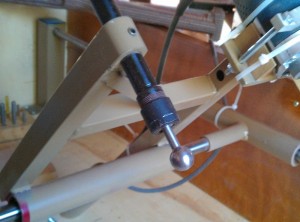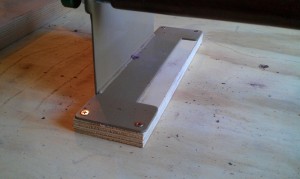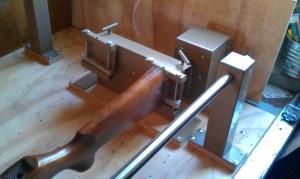I collect a old rifles in assorted states of disrepair and bring them back to life and many times they have broken stocks. I bought the radarcarver to be able to duplicate the broken stocks in new wood and fancy laminates. I wish I would have found a review like this before buying the radarcarver. If you are looking for a thumbs up or thumbs down review, this thumb is sideways but it can be brought up to acceptable hobby use with some tweaking and extra purchases.
Let’s start with the manufacturer’s claims from their website:
“The entire machine is absolutely rigid and non-flexing. Because of this, extreme accuracy is standard.”
False. The main long rails flex with a little pressure such as you resting your arm on the rail. This causes the main yoke with the stylus and router to rotate and cut deeper than you expect into the side of your work.
“Setup is accomplished in a matter of minutes on your own table, which can be as simple as a piece of plywood. “
True. A nice thick piece of one inch ply or OSB is perfect.
“It will exactly duplicate a stock in about an hour and has superb accuracy.”
A Model 1 out of the box won’t. Figure two hours and accuracy based on your own practice and skill.
The price point was right so I got the model #1 with the longer rails, additional clamping head and motorized rotating unit. There are some other things you should get before diving into your first project:
Dust control. I got this nice little Delta unit on Amazon which will do fine. You’ll also need some extra hose and collector to make a collector attached to your router.
Next, take the stylus holder that comes with it and throw that piece of crap away.

It’s off center for ‘adjustability’ but if you adjust one direction X or Y direction, it un-adjusts the other. Plus the set screw that holds the stylus in place digs into the shaft of your stylus making it nearly impossible to remove and ruining your stylus. Get a collet extender from a machine shop supply place, it’s waaaaay better. 5/8″ shaft, 1/4″ collet, 6″ length. I think I paid about $75 for mine.

Get a good solid table to work on. I got this fabric measuring table from a local walmart that closed. It’s rock solid and has raised metal rulers all the way around which are very handy. I screwed my plywood right into the table.

The other thing I didn’t like was the setup was not tall enough to duplicate larger gun stocks, and the whole setup had to be raised. Go ahead and make little plywood risers for all of your components.

I prefer to have the cutter AWAY from me. Set yours up like this too, you want your hand on the stylus.
Make a little rack for all of your styluses and bits.

I also have a pair made of a long straight 1/4 mill bit and matching plain stock for the stylus for deep in-letting. This is a requirement if you are doing gunstocks as the short bits that come with it will result in your router collet grinding into the edge of your work as you try to force the short bits into the inlet. Plus with a long bit you can have your router perpendicular to your work instead of rotated as you try to go deep.

Once you have all your pieces attached to your table, get that dust collector setup with something like this to gather the dust. It’s wont get all of the larger bits but it will get the dust. You want this. You and the garage will be covered in dust in 3 minutes if you don’t. I just used some zip ties and scrap wood to get it right where the main dust stream shoots right into it.

I Also used some scrap closet door and plywood to make walls around the work to keep the wood chips from flying all over and came up with this nice little workplace setup:

So, now that you are all setup and ready to make tons of sawdust here are some tips on technique:
This unit flexes. you will lean on the guide rail and the side of your bits will rotate and cut too deep into your wood. So after about 2 dozen marginally acceptable stocks I came up with the following tips which has since resulted in really good, even sell-able work!
- Let the router do the work. This means don’t force the bit hard into the wood. Let the speed of the bit do the work, not the pressure.
- Get a longer 1/4 stylus and mill bit if doing any in-letting.
- Get the copycarver bit and stylus sets.
- Get the larger router option. It will save hours of work in the long run.
- Cut ‘thick’ meaning adjust the cutter height to leave some meat on the cut wood. You can sand the defects from the bit cutting too deep, later.
- Cut on the top of the work only, don’t try and cut ‘down the sides’.
- Cut as much wood off the new stock as you can with a saw prior to using the router.
Now because this thing flexes and bends like a Romanian gymnast you have to keep that in mind. If you push the yoke (the thing with the stylus and router on it) too hard, the yoke bends. It didn’t take much pressure on the yoke or rails to ruin a dozen stocks like this before I figured out a good technique:

Pushing on the yoke too hard sent the cutter too deep sideways into the surface, same with leaning on the main bar. What I have learned to do is once the stylus and cutting bit are perfectly matched into position, I hold the stylus off the original with my fingertips, about 1/8 of an inch so if it does bend and flex sideways into the new stock, I have some extra thickness to be able to sand it flush. You can also just raise your cutter high into the router a tiny bit to do the same thing. Keep in mind this only works on the vertical axis, not sideways, so cut as much as you can on the top surface and rotate it when you get tempted to cut down the sides with the side of your bit.
- Start with the square ended cutter to do the gross wood removal, leave 1/4 to half an inch on the stock.
- Then use the round edged cutter to get close, until it looks like this. It’s still rough but I have about a 1/16 thick layer extra left on the new stock:

- Then use the fine copycarver round bits to do the final surface. By using increasingly fine bits it reduces the temptation to cut too close and do damage to your final surface.

Using this setup, practice and tips you will be able to put out a good smooth stock in about 2 hours!





26 Responses to Radarcarve gunstock duplicator review